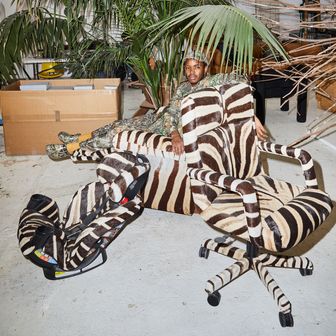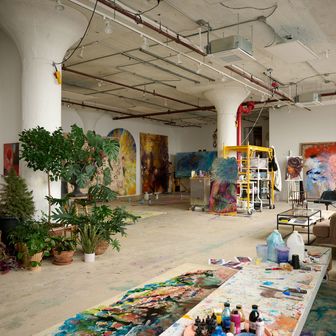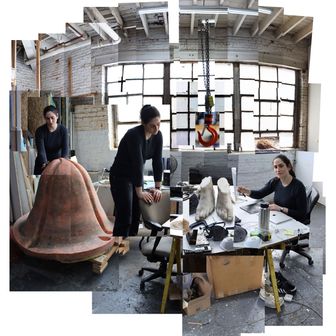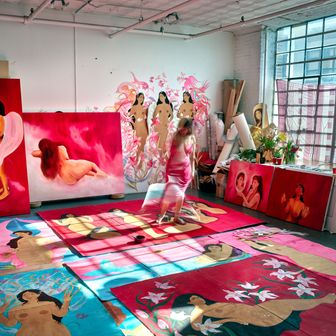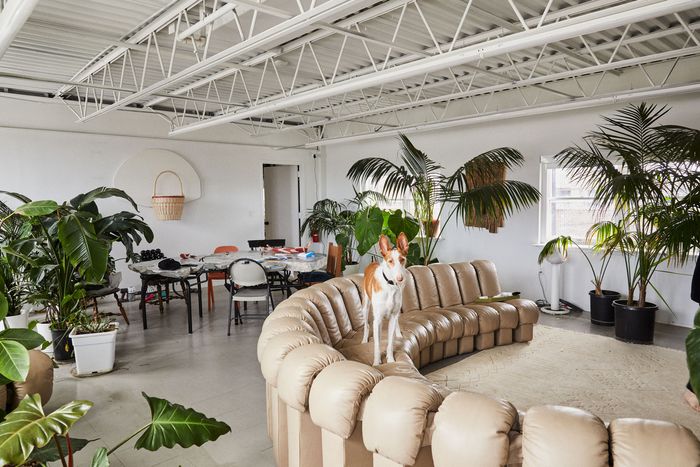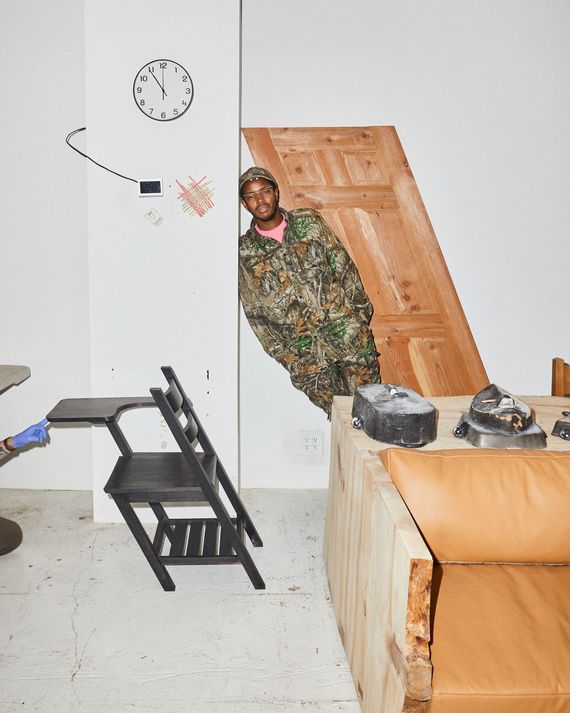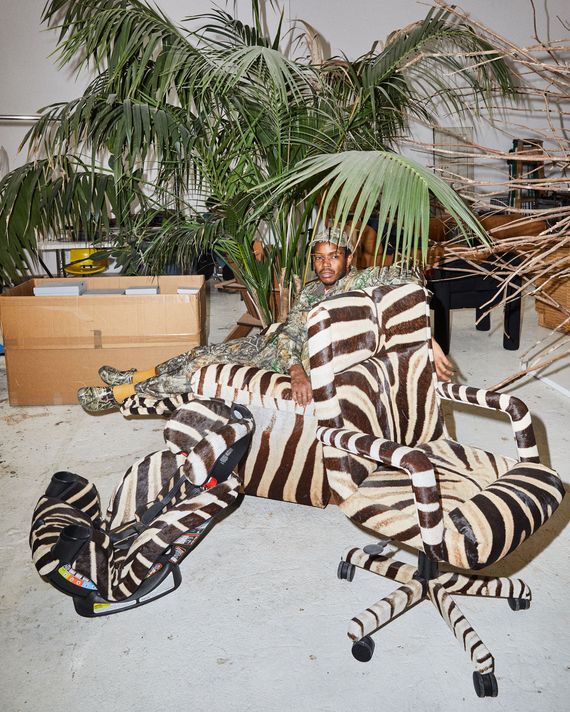
I had outgrown my previous studio in the Bronx,” Hugh Hayden says, sitting beside an aluminum and wood zebra skeleton sprouting massive branches from its bones. He needed more space to make large pieces for a show at ICA Miami in 2021 and had looked at plenty of listings through the website LoopNet, which focuses on commercial real estate. Prices were too steep for what he needed, until he happened upon a former fruit distributor’s warehouse.
“I actually didn’t like it,” he says of his first visit to the fluorescent-lit, cinderblock-walled structure, “but it ended up being a good deal.”
The two-level space totals about 5,500 square feet with 18-foot ceilings and a garage door on the ground floor, where Hayden has his wood shop and sculpting studio. On the lower-ceilinged second floor, there is a kitchen, an office, and a hangout room, where he and his staff gather for lunch.
Design Hunting
Art Studios Week
Wendy Goodman visits four studios in four neighborhoods.
Hayden knew what he wanted to do with it. “I had this vision that putting Sheetrock on the walls, as well as painting the walls, floor, and ceiling, would completely transform this space.”
It’s now his design laboratory, where his fantastical anthropomorphic sculptures are created to address a constant theme. “There’s still this overarching fascination and exploration,” Hayden says, “of trying to inhabit the American Dream — more specifically, this metaphor of camouflage and this idea of blending into a natural landscape is sort of, for me, represented by blending into a social landscape, so that was my fascination with vegetation and the landscape and the environment.”
That fascination plays out in pieces throughout the studio, where his dog, Mars, wanders amid towering plants. On the walls are skeletons and rib cages made of carved wood. They are not, he says, a symbol of death but a representation of our shared humanity: “When you see a skeleton, you don’t know the gender, or race, or sexuality.”
A collection of seating called “Pride,” from his 2021 ICA Miami Show, “Boogey Men,” is covered in actual zebra hide. “The notion is that zebras work together as a group to camouflage and appear like a bigger organism,” he explains. “So their camouflage works like a family.” The pieces represent different stages of life for each family member — a car seat is childhood, an office chair is adulthood, and a recliner is about getting older.
Growing up in Dallas, “I had this entrepreneurial spirit,” Hayden says. He built a koi pond in his family’s backyard when he was in ninth grade. “I didn’t know that you could be an artist,” he says, but he knew he wanted to leave Texas. His conservative high-school guidance counselor didn’t get it, dismissing the idea of going to RISD, where, he was warned, the students wore only black and had tattoos and piercings.
He ended up at Cornell studying architecture. He graduated in 2007 and won second prize in a travel fellowship sponsored by Skidmore, Owings & Merrill with a proposal for researching culinary installations and food-related architecture. He went to work for architect Adam Tihany but was laid off in 2009 during the Great Recession.
That’s when he started honing his sculptural practice in furniture in Brooklyn. He also met artist Derrick Adams. “He was one of the first people I met who said they were an artist, and he was a full-time artist; he didn’t have another job. Also, the work he was making was from his perspective as a Black man, and I had ideas about the world, but I didn’t know there was an audience for them, or a way to make them and display them, or that you could have a career or livelihood from it.”
Before he became an artist, he worked on store design for the fashion brand Alice + Olivia and Starbucks. He earned his M.F.A. from Columbia in 2018.
His upstairs office is where he goes to work on projects at the end of the day, after the rest of the studio has gone home. It’s filled with woven baskets, each one unique. There are finished pieces displayed on the walls, while those in process are scattered across his desk, all the result of teaching himself to weave during the pandemic.
Communal cooperation is important to him. In 2016, he created an installation around a table where diners were tethered together and had to coordinate their movements to eat. Later, for his birthday in 2020, he made a rocking table, where everyone had to work together to keep the surface from flipping over to use it.
“I made that as a nightlight for myself back in 2014. It’s incomplete and has never been shown.”
The Barbie-doll hoop, a study from 2022.
A zebra-tail detail from the “Pride”-series recliner.
Armor, made from cherry bark applied to a Burberry coat, from 2014.
Workstudy is from 2018 to 2023.
BEC, made of yellow enameled cast iron, from 2021.
Ball Chair, from 2009.
This piece, with a bald cypress sprouting out of an aluminum zebra, was originally shown at his gallery, Lisson, last summer — “I’m now transforming it into a new piece.”
A Birkin bag covered in bark for a collector this year.
A woven basket in process.
“I made that as a nightlight for myself back in 2014. It’s incomplete and has never been shown.”
The Barbie-doll hoop, a study from 2022.
A zebra-tail detail from the “Pride”-series recliner.
Armor, made from cherry bark applied to a Burberry coat, from 2014.
Workstudy is from 2018 to 2023.
BEC, made of yellow enameled cast iron, from 2021.
Ball Chair, from 2009.
This piece, with a bald cypress sprouting out of an aluminum zebra, was originally shown at his gallery, Lisson, last summer — “I’m now transforming it into a new piece.”
A Birkin bag covered in bark for a collector this year.
A woven basket in process.
More Great Rooms
- Just Follow the Red Door Through the Trees
- A Jubliantly Traditional Carnegie Hill Classic Six
- Object & Thing Goes to the Beach


